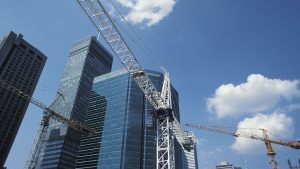There’s a famous line from the movie Field of Dreams: “If you build it, they will come.”
That may ring true for commercial projects like stadiums, office buildings and shopping centres. However, when it comes to government-sponsored climate infrastructure, action has lagged far behind the need.
Today, British Columbia is Canada’s frontline facing the first of several future climate catastrophes foreseen by environmental scientists for years.
The smoke, fire, floods and landslides in British Columbia have shown why a systematic change in attitude is needed, one that uses climate projections for guidance rather than historical data. It’s the same outlook used by successful stock market players. Good investment decisions are not based solely on past performance but on future prospects.
Although B.C.’s Deputy Premier Mike Farnworth told the CBC Fifth Estate that the situation in his province was “unprecedented,” it was certainly predicted.
Canada has been in smug denial to this point, feeling immune to the worst repercussions of climate change while climate-driven fires and floods impact many other parts of the world. Suddenly, there’s a lot of blame being thrown around, from Canadian government leaders who make GHG reduction pledges at international conferences, to provincial governments who pass down mitigation efforts to small towns and municipalities without funding the actions required to protect their communities.
The construction industry does not have to wait for growing public pressure to force federal and provincial governments into decisive action. That could take more time than the current situation allows.
Fundamental to the many proactive roles that can be played by the construction industry is planning and engineering. This requires the same change in perspective as with governments, that is, away from regarding historical data as the sole guide to design and planning to an embrace of forward-looking, science-based environmental projections.
It’s taken a while to develop an acceptable foundation for this shift. But finally, the Engineers and Geoscientists in British Columbia, the province’s regulatory and licensing body for those professions, put their heads together.
In 2018, it formed the Engineers and Geoscientists BC’s Climate Action Plan Steering Group. Their objective: “To guide Engineers and Geoscientists BC in responding to climate change issues proactively, and to better support its registrants in implementing climate change considerations in their work.”
These engineers and geoscientists recognized the very critical issue of addressing the future.
“It is no longer appropriate to base engineering and geoscience practice solely on historical climate data and methods. Managing climate risk means considering the current and projected changes in climate and the associated consequences and uncertainties of those changes.”
In March 2021, the organization published its Climate Change Action Plan. It sets out a strategy to develop a clear mandate to encourage, act and advise on proactive measures in response to climate change. The plan provides support for efforts to meet professional responsibilities to clients and project owners.
The plan begins with 10 action steps addressing GHG reduction and climate change, from leadership and collaboration, education and knowledge sharing, to practice guidance and support.
Seven desired outcomes are sought. In terms of adapting to climate change, the goal is to give engineers and geoscientists, “a functional understanding of the changing climate and risk assessment and risk management principles and can incorporate these principles into their roles and areas of practice, as appropriate.”
From this, it is hoped their knowledge and understanding will influence the scope and direction of regulations, codes and standards that can address the effects of the changing climate.
It is accepted that GHGs are the root cause of today’s climate crisis. At the federal and governmental provincial levels, climate action studies are plentiful but out of date. For example, it’s been 10 years since the publication of Climate Ready — Ontario’s Adaptation Strategy and Action Plan.
Yet, governments are not only failing to reduce their GHG emissions at a pace sufficient to meet their publicly-announced commitments, they continue to act retroactively to a predictable future.
John Bleasby is a Coldwater, Ont.-based freelance writer. Send comments and Climate and Construction column ideas to editor@dailycommercialnews.com.











Recent Comments
comments for this post are closed